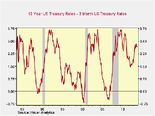In the past 24 hours, I’ve had several discussions that centered on the question “What do we do now?” During one, on Fox Business News yesterday afternoon, the anchor pointed out that, even as I was cautious on equities, the market had climbed a wall of worry all year—and looked likely to continue to do so. Does that make caution on equities wrong? Similarly, I was talking with a Wall Street Journal reporter this morning about where the market was going, and we got into the continuing government confrontation, earnings, and the real economy—all without coming to any real conclusions.
First things first: The fact that the market keeps going up doesn’t mean everything is all right. Under that standard, the housing market was perfectly fine in 2007, so I don’t think the fact that the market is rising means caution is inappropriate.
The important question here is why the market is rising. The correlation between the market’s climb and the Fed’s expansion of its balance sheet, while real and very high, has been amply covered. I’ve written before about how the market has risen much more than the underlying increase in earnings, so I won’t repeat that here. Instead, let’s take a look at a different and even more troubling stat—the correlation between the market and debit balances at broker/dealers.
Part of the Federal Reserve’s goal in keeping interest rates low was to encourage investors to move into riskier assets like stocks, both by making returns on bonds low and by making it easier and cheaper to borrow or buy riskier assets. Based on the chart above, it looks like the Fed succeeded and that borrowing has risen with the market.
Now, you can argue, correctly, that correlation is not causation, but doesn’t it look just a bit worrisome that we’re now at the borrowing levels of 2007? This certainly doesn’t mean anything immediate, but in the context of a still-weak economy, political uncertainty, and earnings that appear to be topping, any future buying will require even more margin debt—which may limit future appreciation, so to speak, if interest rates were to increase.
The other thing I have in mind when I suggest caution is valuation, which I’ve written about many times before. Suffice it to say, while we can argue about whether and how expensive the market is, it’s hard to say it is cheap. The only argument for cheap, in fact, is in comparison to current very low interest rates. If you expect those rates to remain low indefinitely, then the market may well be cheap. If not . . .
The solution, if you’re worried about price levels and valuations, is to look for opportunities that are more reasonably priced. On our research quarterly call the other day, we used a very good chart about where values are, courtesy of J.P. Morgan.
Based on this data, the U.S. does indeed look expensive, while Europe and many emerging markets look inexpensive. Would you rather buy at a discount or at a premium? Which isn’t to say that expensive can’t get more expensive and cheap can’t get cheaper. Many of these markets are cheap for a reason—and far from working out their problems—and the U.S. market may well continue to run for a while.
In the short term, it’s not really possible to predict markets. Over three-plus years, though, you can develop some insights. One of the best indicators for future returns is current valuation, with lower ones indicating better future returns. I prefer multiyear trailing earnings as a basis, but single-year trailing earnings are almost as good. What isn’t a good predictor are P/E ratios based on future earnings estimates, which change radically over the course of the quarter. Using these metrics, future returns for U.S. markets at the valuation levels we have now—based on historic results, and bearing in mind that it might be different this time—have been disappointing.
Part of the solution for an expensive U.S. market is therefore to invest a larger part of your equity portfolio in cheap markets, rather than expensive markets—otherwise called geographic diversification. Another part, though, should be strategy diversification. Asset class and geographic diversification aren’t enough; you should be using different strategies as well. Examples might include long/short strategies for both equity and fixed income, convertible bonds, and covered call strategies, all of which do not rely on continued price appreciation to succeed.
In many respects, all I’m calling for when I argue caution is not putting all your eggs in one basket. Yes, it’s a great basket and has done well over the past couple of years, but I remember when it got dropped about five years ago. Diversification is most important when no one really thinks it necessary, and it seems we may be getting to that point.


 Print
Print





